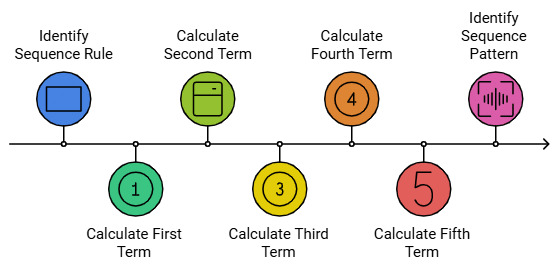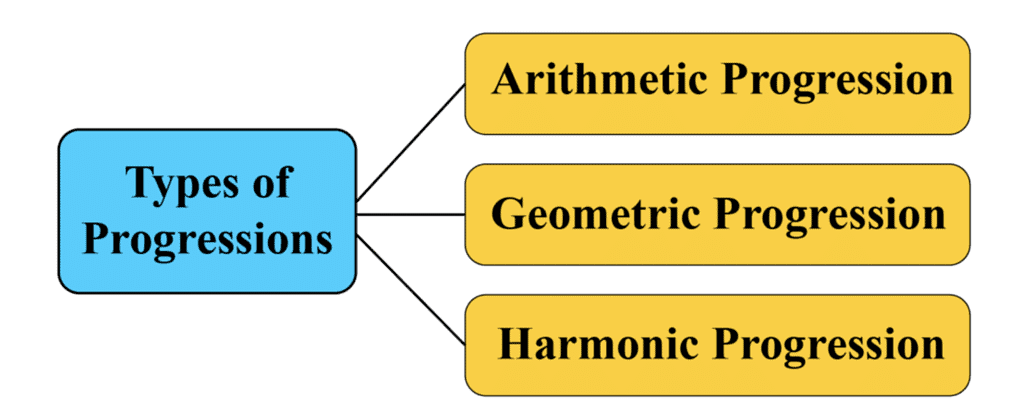Facts that Matter: Arithmetic Progressions | Mathematics (Maths) Class 10 PDF Download
| Table of contents |

|
| Sequence |

|
| (i) Finite Sequence |

|
| (ii) Infinite Sequence |

|
| Progressions |

|
| Arithmetic Progression (A.P.) |

|
An Arithmetic progression is a specific type of sequence in which the gap between a term and the term before it remains the same every time.
This constant gap is called the common difference and is denoted as 'd'. We usually refer to an arithmetic progression as A.P. So, it can be written as a, a + d, a + 2d, and so on.
Sequence
When some numbers are arranged in a definite order, according to a definite rule, they are said to form a sequence. The number occurring at the 1st place is called the 1st term, denoted by T1.
The number occurring at the 1st place is called the 1st term, denoted by T1.
The number occurring at the nth place is called the nth term, denoted by Tn.
Example: Let us consider a rule
Tn = 3n + 1
Putting n = 1, 2, 3, 4, 5, ..... we get
T1 = 3 (1) + 1 = 4
T2 = 3 (2) + 1 = 7
T3 = 3 (3) + 1 = 10
T4 = 3 (4) + 1 = 13
T5 = 3 (5) + 1 = 16
...... ...... ......
...... ...... ......
...... ...... ......
∴ The numbers 4, 7, 10, 13, 16, ..... ..... form a sequence.
The pattern followed by its terms is:
To start with 4 and add 3 to each term to get the next term
There are two types of sequences
(i) Finite Sequence
A finite sequence in arithmetic mean refers to a sequence of numbers where each term is obtained by adding a fixed value (known as the common difference) to the previous term. This results in a sequence of numbers that form an arithmetic progression (A.P.).A sequence containing a definite number of terms is called a finite sequence.
For example, let's consider the finite sequence: 2, 5, 8, 11, 14. This sequence follows an arithmetic progression with a common difference of 3. The arithmetic mean of this finite sequence can be calculated as:
Arithmetic Mean = (2 + 5 + 8 + 11 + 14) / 5 = 40 / 5 = 8
So, the arithmetic mean of this finite sequence is 8. It represents the average value of the terms in the sequence.
(ii) Infinite Sequence
An infinite sequence in arithmetic progression refers to a sequence of numbers where each term is obtained by adding a fixed value (known as the common difference) to the previous term. This results in a sequence of numbers that continues indefinitely in both the positive and negative directions. Such a sequence is also known as an arithmetic series. A sequence containing an infinite number of terms is called an infinite sequence.
For example, let's consider the infinite sequence: 3, 6, 9, 12, ... Here, the common difference is 3, and each term is obtained by adding 3 to the previous term. The sequence continues indefinitely as 15, 18, 21, and so on.
Progressions
The sequences in which each term (other than the first and the last) is related to its succeeding term by a fixed rule, are called progressions.
Note:
There are three types of progressions:
I. Arithmetic Progressions (A.P.)
II. Geometric Progressions (G.P.)
III. Harmonic Progressions (H.P.)
But, here we shall learn about arithmetic progression.

Arithmetic Progression (A.P.)
An arithmetic progression is a list of numbers in which each term is obtained by adding a fixed number to the preceding term except the first term.
The fixed number is called the common difference, which can be positive, negative or zero. The common difference of an A.P. can be obtained by subtracting any term from its following term. Generally, the first term is denoted by ‘a’ and the common difference is denoted by ‘d’. If three numbers a, b, c are in order, then (b – a) = common difference = (c – d) When a certain number of terms of an A.P. are required, then we select the terms in the following manner:
Number of Terms, Terms and Common difference
Number of Terms | Terms | Common difference |
3 | a – d, a, a + d | d |
4 | a – 3d, a – d, a + d, a + 3d | 2d |
5 | a – 2d, a – d, a, a + d, a + 2d | d |
6 | a – 5d, a – 3d, a – d, a + d, a + 3d, a + 5d | 2d |
nth term of an Arithmetic Progression
Say the terms a1 a2 a3……an are in AP. If the first term is ‘a’ and its common difference is ‘d’. Then, the terms can also be expressed as follows,
2nd term a2 = a1+ d = a + d = a + (2-1) d
3rd term a3 = a2 + d = (a + d) + d = a + 2d = a + (3-1)d
likewise, nth term an = a + (n-1) d
Therefore, we can find the nth term of an AP by using the formula,
an = (a + (n – 1) d)
an is called the general term of an AP
Sum of n terms in an Arithmetic Progression
The sum of first n terms in arithmetic progressions can be calculated using the formula given below.
S = [(n/2) x (2a + (n – 1) d)]
Here S is the sum, n is the number of terms in AP, a is the first term and d is the common difference.
We can write the above equation as S = [(n/2) x ( a + a + (n - 1)d)]
And, we know that an = (a + (n – 1) d)
So, when a and an are the first term and the nth term of an AP. Then, the sum of n terms can also be written as
S = [(n/2) * (a + an)]
Properties of Arithmetic Progressions
- If the same number is added or subtracted from each term of an A.P, then the resulting terms in the sequence are also in A.P with the same common difference.
- If each term in an A.P is divided or multiply with the same non-zero number, then the resulting sequence is also in an A.P.
- Three number x, y and z are in an A.P if 2y = x + z.
- A sequence is an A.P if its nth term is a linear expression.
- If we select terms in the regular interval from an A.P, these selected terms will also be in A.P.
Some examples to help you practice solving Arithmetic Progressions (APs):
Example 1: Find the nth Term of an AP
Given an arithmetic progression: 3, 7, 11, 15, ...
Find the 10th term of the sequence.
Sol:
First, identify the first term 'a' and the common difference 'd'.
a = 3 (first term)
d = 7 - 3 = 4 (common difference)
Now, you can use the formula for the nth term of an AP: nth term = a + (n - 1) * d
Plug in the values:
10th term = 3 + (10 - 1) * 4
10th term = 3 + 9 * 4
10th term = 3 + 36
10th term = 39
So, the 10th term of the sequence is 39.
Example 2: Find the Sum of an AP
Find the sum of the first 15 terms of the arithmetic progression: 2, 6, 10, 14, ...
Sol:
First, identify the first term 'a', the common difference 'd', and the number of terms 'n'.
a = 2 (first term)
d = 6 - 2 = 4 (common difference)
n = 15 (number of terms)
Use the formula for the sum of the first 'n' terms of an AP: Sum = (n / 2) * (2a + (n - 1) * d
Plug in the values:
Sum = (15 / 2) * (2 * 2 + (15 - 1) * 4)
Sum = 7.5 * (4 + 56)
Sum = 7.5 * 60
Sum = 450
So, the sum of the first 15 terms of the sequence is 450.
|
126 videos|457 docs|75 tests
|
FAQs on Facts that Matter: Arithmetic Progressions - Mathematics (Maths) Class 10
| 1. What is the difference between a finite sequence and an infinite sequence? |  |
| 2. How do you identify an arithmetic progression (A.P.)? |  |
| 3. What is the formula for finding the nth term of an arithmetic progression? |  |
| 4. How can I find the sum of the first n terms of an arithmetic progression? |  |
| 5. Can an arithmetic progression have a negative common difference? |  |

|
Explore Courses for Class 10 exam
|

|


















